Garmin 245 Review
I was nervous as I started my preparation for this Garmin 245 Review; would Garmin’s latest Forerunner still be a proper runners’ watch or have Garmin sold out to the music crowd? Then again, might Garmin have played their best card and produced something to qualify as the Best Running Watch for 2021? …let’s see in the super-detailed review further below and the summary starting now…
In Brief
-
Value For Money - 85%
85%
-
Accuracy - 90%
90%
-
Build Quality & Design - 90%
90%
-
Features, Including App - 95%
95%
-
Openness & Compatability - 95%
95%
Summary
 The Forerunner 245/245M is a solid, new, high-tech running watch with almost all of Garmin’s running-specific features plus the key smart features like notifications, payments and music. It does everything in a smaller-sized shell that’s suitable for many wrists.
The Forerunner 245/245M is a solid, new, high-tech running watch with almost all of Garmin’s running-specific features plus the key smart features like notifications, payments and music. It does everything in a smaller-sized shell that’s suitable for many wrists.
It’s a box-ticker. Imagine an Amazon Warehouse, somewhere, full of boxes…the Forerunner 245 would have a good attempt at ticking all of them for most levels of runner. If I was busy and someone asked me for a running watch recommendation, without thinking I’d probably say “Go for the Forerunner 245“…it’s a safe recommendation unless you have very specific needs. You get the picture.
Garmin’s free running plans are suitable for runners up to a fairly good level and other features like PacePro are perfect for high-level runners looking for specific pace guidance. I love the market-leading compatibility with STRYD and you might love it for its ability to support 10s and 10s of sports profiles and for the emergency alerts and female health tracking.
You will be able to link to any modern running sensor or smartphone and the Garmin Connect app is packed full of every feature you can think of, albeit a little complex to use at times.
Pros
- Feature-tastic – it does all the running stuff you want and more besides.
- Market-leading MUSIC offering for a sports-grade watch – SPOTIFY, Deezer & more.
- Market-leading GARMIN CONNECT app and sports platform
- Good choice of free apps through Garmin’s CIQ Store.
- Interesting, free Garmin Coach option for novice-medium level runners
- Interesting physiology and training insights for all levels of runner from Firstbeat.
- Links to many sports sensors and sports platforms like STRAVA & MyFitnessPal
Cons
- Price – You could possibly find a cheaper alternative that still does the job YOU need a running watch to do. Maybe you could save yourself up to $/£70 with a bit of research into the many competing alternatives?
- Running Dynamics – not actionable for most people.
- Format – some of you might prefer a slightly larger format watch
I’ll start with some general comments to help in your purchasing thought process before returning to go through some of the key aspects of the watch in more detail. The review is long so either skip to your favourite section or just sit back and enjoy the ride.
The Headline
The key differences with the Forerunner 245 compared to the older 235 are that the new Forerunner 245 has more smart features like music (optional), a few more true sports features like running dynamics and physiology features from Firstbeat. Perhaps, more importantly, is that the Forerunner 245 has totally upgraded internal hardware components and looks more like a 24×7 watch than the sports watch that was the Forerunner 235.
The next model up is the slightly better-featured Forerunner 645 (Music).
Why You Would Buy The 245?
It’s a ‘safe bet’.
If you’re unsure what to buy then that one sentence probably sealed the deal for you.
The Forerunner 245 has every feature that a novice runner needs…and more besides for higher-level runners. It doubles up as a very good 24×7 smart activity tracker and, if you want music to run to, then you’ve got it in the 245M model. Let’s say you consider yourself to be an ‘intermediate level’ runner who wants to follow clever, adaptive training plans or who wants some more insights into improving running technique. Yep, you’re good to go as well.
It’s even a relatively ‘small’ size and great for thinner wrists, yet does that without sacrificing anything with the screen size when compared to other Garmin models.
Why You Would NOT Buy The Forerunner 245 (Music)
Let’s try these…
- Cost is always a factor when looking at a new Garmin…there is always something cheaper.
- Maybe the aesthetic is not quite right for a 24×7 watch despite it having the features to be one.
- You just run and don’t really see too much of a need for a sports watch to get faster.
If you want something cheaper then consider a Polar Ignite 2 or Suunto 3 Fitness and if you want a Garmin then the Forerunner 55 is the perfectly competent model below.
Garmin 245 Review – The Details
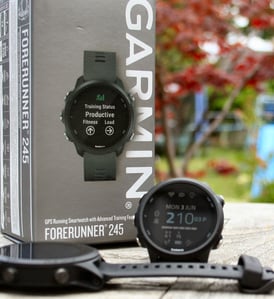 OK. Let’s crack on with the review.
OK. Let’s crack on with the review.
This Garmin Forerunner 245 Review will look at different aspects of how you will interact with the watch and describe my opinions and experience with those. I’m thinking things like RACE USAGE, DESIGN ISSUES, FOLLOWING A PLAN, TRAINING USAGE, GETTING INSIGHTS INTO PERFORMANCE and ASPECTS of SMARTS & CONNECTIVITY but I’ll also do the standard bits like GPS accuracy, oHR accuracy and a short unboxing.
I’m NOT going to walk you through the menus nor am I going to show you photos of every component and screen from every angle. Neither am I particularly going to tell you how to do stuff with the 245…there is a manual or video somewhere for all of that kind of thing.
So this is more of a “What to expect” review…which I hope will be more useful (comments below if not…I aim to please)
Garmin Forerunner 245 Review – Unboxing
You get the watch, a manual and a bespoke USB charger. That’s it.
 The bespoke connector works fine for general charging and fits either way around. The main issue I have is that when there is sweat or pool water inside the port (hole) on the watch, then the 245 can fail to make a connection to my PC. The solution is to blow into the watch port to get the sweat out or use the Connect Mobile app.
The bespoke connector works fine for general charging and fits either way around. The main issue I have is that when there is sweat or pool water inside the port (hole) on the watch, then the 245 can fail to make a connection to my PC. The solution is to blow into the watch port to get the sweat out or use the Connect Mobile app.
Garmin Forerunner 245 – Sports Usage
On a day-to-day basis you will interact with the Garmin 945 FOR SPORTS in these main areas: Organising training, executing training and analysing training results. And you might do that for sports other than running like riding or going to the gym.
On the whole, Garmin has all of this SPORTS USAGE completely covered. It’s what Garmin do.
There are a few chinks in what it does NOT do well. Firstly that is the deeper workout analyses and secondly, are the general usability issues that drag down the whole experience a little more than they should.
OK, let’s put some flesh on that.
Organising Training
ie Here we are talking about planning, creating and scheduling workouts. You might do that yourself or from a plan…or not at all.
Garmin links to the calendar from your smartphone and overlays workouts for today and the days ahead. So today I have a “W03D6 – Build Run” just allocated seemingly to “anytime today” (which is great) and there’s also ‘Coffee with Jim at 11:00’ and ‘Zumba at 18:30’ which is strange as I don’t do Zumba, so I’m guessing we have a family calendar somewhere on Google that Garmin has magically commandeered.
It gets better.
 Training Plan functionality is embedded within your Garmin Connect platform and you can get access to a wide variety of running plans…for free. Most of these plans are fixed but now Garmin is gradually starting to expand a new tranche of (free) ADAPTIVE PLANS called GARMIN COACH. Again you find this in the Training Plan area of Connect but these adaptive plans change and morph as your week progresses or regresses due to other commitments. “Worked late and can’t run today?…the plan automatically adjusts for that tomorrow.
Training Plan functionality is embedded within your Garmin Connect platform and you can get access to a wide variety of running plans…for free. Most of these plans are fixed but now Garmin is gradually starting to expand a new tranche of (free) ADAPTIVE PLANS called GARMIN COACH. Again you find this in the Training Plan area of Connect but these adaptive plans change and morph as your week progresses or regresses due to other commitments. “Worked late and can’t run today?…the plan automatically adjusts for that tomorrow.
For those of you who want to create and schedule your own complex, structured workouts then Garmin have one of the most comprehensive workout creation tools. They have had it for YEARS and so it works. You can create any kind of complex workout and set a wide variety of training targets as part of the workout.
Sometimes you might not want that kind of organisation for your training…and that’s OK. Instead, you might want to:
- set a simple distance, pace or time target.
- race a virtual pacer;
- race a particular STRAVA segment (via CIQ);
- race a previous effort of your own or from someone else where you are shown how far ahead or behind you are; and
- create simple, repeated intervals on the watch.
Summary: Generally Very Good.
Training or Racing – Garmin Forerunner 245 Review
The Garmin Forerunner 245 is great at it’s primary purpose…training and racing.
There are subtle nuances of how the 245 works across many fully customisable, sports profiles; what you need when running are the means to safely monitor, manage and control your effort in relation to whatever ‘goal’ you might be trying to achieve that day. That sounds simple but Garmin’s solution is a highly involved and comprehensive one.

In simple terms, you need to be able to see the appropriate metrics and be alerted when stuff happens…or should happen…or doesn’t happen.
- A metric is a measure of ‘something’ like heart rate. But it could equally be running pace or cadence or distance or laps or elapsed time or even a Firstbeat metric like ‘Real-Time Performance Condition’. But it could also be those metrics viewed over the entire workout, or over the last manual lap, or over the last automatic lap, or over a ‘segment’. It could also be a mathematical variation on one of the metrics such as %HRmax or which HR zone you are in ie metrics get complex, very quickly. To cut a long story short, your Garmin 245 will be able to handle many of these. Admittedly the competition is generally fairly close to offering the breadth that Garmin does…fairly close.
- To some degree, there are also metrics that can be used to help you work on technique like those found in the ADVANCED RUNNING DYNAMICS.
- Your Garmin Forerunner 245 will also support weird stuff too like native SmO2 (muscle oxygen) or 3rd party running power which can be incorporated, with restrictions, through Garmin CIQ apps & CIQ data fields.
- Alerts can happen when one of your sports metrics reaches a certain threshold. That could be a certain heart rate zone or it could be a time threshold where you might want to be reminded to take on hydration or simply alerted that your 5 minute effort period is over.
- You can set these alerts manually for a workout or they can be automated as part of the workout/plan that you are following. Your alerts can be a vibration, an audible beep or even audio prompts through your Bluetooth earbuds (245M only) – clever stuff indeed!
- One of the most commonly used alerts will be the lap alert and you can configure what is shown when the alert pops up eg you might want to see ‘lap average pace’ and ‘lap average hr’. And you can change that for a different sport profile as well as manually taking a lap.
- You can also customise all of that on your screen layout. There are ways to get more than 4 fields per screen (via CIQ) and you can even get colour-coded data fields and unusual data fields like ‘dials’
- Group training and security issues whilst training are handled by the connected features of GroupTrack, LiveTrack and Assistance.
A couple of final points here that will be important to some of you. YES, you can create simple intervals on the fly rather than needing to follow a workout you have created and sync’d beforehand. And YES you can also set targets for your workout like distance/time and pace – although having said that I am a little surprised that it does not seem to be possible to set a TRAINING EFFECT target on the fly based on Firstbeat data. Finally, you can race a previous activity of yours or someone else, which is a neat feature.
Training or Racing – specific Running Environments
 We all run in different places and can have some different needs as a result. The Garmin Forerunner 245 has these mostly covered and there is even the ability to navigate over a predefined track with a GPS compass.
We all run in different places and can have some different needs as a result. The Garmin Forerunner 245 has these mostly covered and there is even the ability to navigate over a predefined track with a GPS compass.
- Triathlon – Whilst the Forerunner 245 does have POOL SWIM and BIKE PROFILEs, it is not really a triathlon watch as it is not possible to go seamlessly from one sport to the next. But it only takes a few seconds to switch between them if you are only ever going to do one triathlon for fun a year. The extended display mode is also a feature that might make the 245 good for a triathlon when combined with a Garmin Edge
- Treadmill – The Forerunner 245 is treadmill capable and can get cadence fro the wrist. It should estimate pace/distance from the wrist too but if you want accuracy you will use a footpod.
- Run/Walk – Yes, it has a run-walk mode as well as elliptical and pure-walking modes.
- Extreme/Fell/Ultra Running – Whilst the battery should be good enough for most of you, I can’t see any metrics for grade or vertical-ascent-like metrics.
- There’s an indoor track mode – which means the GPS is turned off!
Training or Racing – Running Specific Issues
Well, you’ve got a metronome and STRYD support (buy one). There’s obviously much more than that and here are some run-specific highlights
- Running cadence can be from the wrist and is sufficiently accurate.
- Race time predictors now from Fristbeat.

Summary: This is all ‘standard stuff’. Whilst it might well be standard, the competition does not do it ALL quite as comprehensively as Garmin.
Analysing Training – Garmin Forerunner 245 Review
Your analysis could be something as simple as just seeing how far you’ve just run or it might be to see your VO2max fitness score. The analysis could also be JUST for the workout you’ve done or it could be to look at the cumulative effect of your training on your race this coming weekend. Furthermore, you might want to analyse the data yourself or share it and compare with friends’ performances, and some of you might even want to send it to a coach.
With just those 3 sentences you can see there is a lot of complexity for a little watch to handle. And Garmin is torn here between providing a LOT of analysis on the watch when, in reality, the watch is not a great size format to do the analysis on. But set against that is the fact that you have just finished your workout and you want to look at it NOW…one thing is for sure, your watch is on your wrist so it’s presence and potential usefulness is timely for analysis.
Well, the Forerunner 945 is surprisingly good at addressing many, but not all, analysis needs. And what it can’t address it can certainly let you send your data ‘somewhere else’ so that ‘someone else or you’ can analyse away to your heart’s content. Then there is also the convenience of the CONNECT platform (web + app) which does NOT give you that much more ANALYSIS but certainly does give the analysis to you in a larger, more easily manageable format.
Analysing Training – Key Post-Workout Stats
Garmin nailed this a few years ago. There are lots of nails in it now. You get ALL the basic info you need like a trail of where you’ve been, average cadence, ascent, descent, load, anaerobic/aerobic training effects, time in heart rate zones, laps, intervals, and more. You can look at that info for any historic workout that’s on your watch.
Analysing Training – Physiological Markers
The Forerunner also determines your running VO2max which can be used to see how your training is progressing. This is then used to score activities and model quite complex things like your training load, training status, recovery levels and race predictions.
So you will see a ‘Recovery Time’ calculation at the end of your workouts and this is the amount of time you should wait until you perform your next HARD workout. Come back in 2 hours and your recovery time should have changed by 2 hours, so you see these types of physiological markers are not linked to the workout and there is a whole section of stuff where you can analyse the ‘state of you’ and this includes things like whether your fitness and load are increasing and if your load is optimal. Also related to this is the ‘All Day Stress & Recovery’ feature which suggests the continual impact of ‘life’ on your energy levels.
 Analysing Training – The Garmin Connect Platform (web + online)
Analysing Training – The Garmin Connect Platform (web + online)
Your data is sync’d back to the Connect platform at some point and it’s pretty much the same sort of stuff that’s on your watch but just in a bigger format. IF you are familiar with other sports-data platforms you might be a bit disappointed but if you are new to running stats then the opposite will probably be true.
Either way, it is what it is. Garmin has never made any pretences to be great at deep sports data analyses. They provide the means to easily send your data elsewhere for that, be it to Training Peaks or STRAVA. I suspect only a small percentage of Forerunner 245 buyers will want much more than what CONNECT has to offer for analysis.
Sharing Training
 Alternatively, you can automatically link your Garmin Connect account to send your workouts to these 3rd party services. The point here, for example, is that you only RARELY have to use the CONNECT platform if all you want to use is STRAVA. You can be blissfully unaware of all the techy glue in CONNECT that links to STRAVA, all you need to know is that your workout is in STRAVA very quickly after you’ve finished it.
Alternatively, you can automatically link your Garmin Connect account to send your workouts to these 3rd party services. The point here, for example, is that you only RARELY have to use the CONNECT platform if all you want to use is STRAVA. You can be blissfully unaware of all the techy glue in CONNECT that links to STRAVA, all you need to know is that your workout is in STRAVA very quickly after you’ve finished it.
- Beginner Triathlete
- Endomondo
- Fetcheveryone
- Final Surge
- Make YES! Happen
- MapMyFitness (MapMyRide, MapMyRun)
- MyFitnessPal
- Nike+
- Runcoach
- Run Keeper
- Strava
- TrainingPeaks
You can also share training whilst you are doing it with LIVE TRACK, GROUP TRACK and LIVE EVENT SHARING where your location/ or laps can be updated to others via your smartphone.
 Design & Specifications
Design & Specifications
This takes a look at the design of the watch, the good bits, the bad bits and how they affect your sporty experiences with the Garmin Forerunner 245 reviewed here.
Overall Design – Appearance
The overall design is of a pleasant-enough looking, smaller-format sports watch. It gives a first impression of appearing unremarkable and the screen glares out at being of a lower resolution and intensity than ones you might find on other smart watches.
It’s a standard 5-button, round sports watch, solidly made with no touchscreen. The screen is a welcomingly hard Gorilla Glass 3. The display is officially classed as “sunlight-visible, transflective memory-in-pixel (MIP)“. This colour technology means that the screen appears somewhat dull, with the colours washed out. It has a fairly good backlight to aid visibility in many light conditions. I know that this description does NOT sound good BUT these characteristics are some of the reasons why the Garmin battery lasts a long, long time. And people WANT longer-lasting batteries….ask any Apple Watch owner.
 The glass face is very slightly recessed below the fibre-reinforced polymer bezel and the bezel is plain. Looking to the side of the watch, the buttons themselves are on the small side but perfectly fine and they operate with an amount of ‘spring-back’ when pressed. The fibre-reinforced polymer case includes a raised, protective area around each button. The buttons could be better designed to give more positive feedback and are hard to use with gloves in winter. But it’s fine.
The glass face is very slightly recessed below the fibre-reinforced polymer bezel and the bezel is plain. Looking to the side of the watch, the buttons themselves are on the small side but perfectly fine and they operate with an amount of ‘spring-back’ when pressed. The fibre-reinforced polymer case includes a raised, protective area around each button. The buttons could be better designed to give more positive feedback and are hard to use with gloves in winter. But it’s fine.
The underside of the Forerunner 945 has the port for the USB charging connector and the latest Garmin ELEVATE optical HR sensor module with 4 slots. The first and third cover the receivers. The second contains a green LED light for HR and the lower one has both a GREEN LED for HR and a RED LED light for SpO2 measurement. This is not the optimal design for an oHR array (Source: Valencell and others). We shall see later whether or not that is materially important in the accuracy received.
The supplied, silicone bands fit wrists ARE easily removed and replaced with (QuickFit) 20mm bands. Nevertheless, the supplied band does the job despite being a bit ‘cheap and cheerful’.
Overall Design – User Interface
 Garmin’s burgeoning feature set has not found its way to the 245 in full.
Garmin’s burgeoning feature set has not found its way to the 245 in full.
As a consequence, you will become familiar with all the quirks and hidden-away intricacies of the 245 just that little bit sooner than someone buying one of the top-end watches. But it IS hard to find stuff you want when it is squirrelled away in the menus. To complicate this, the menus can be accessed in different ways depending on several factors that I’m not entirely sure I understand myself (#10YearGarminUser). There are shortcut menus, widget menus, in-sport menus, sport profile menus and more besides.
The current 2019 crop of new Garmin devices have sought to address the accumulation of poor interface design and good, baby steps have been taken to improve and impress us whenever we press a button or two. But, as the kids say “Are we there yet?”…A: nope.
OK, I AM familiar with most of it in reality. I suppose I’m just saying that Apple would have done it VERY differently and Garmin DO have to somehow cram in the access to an awful lot of features.
Size Comparison

This comparison clearly shows that the 245 is a super-lightweight watch with the current, generic Garmin screen packed into a smaller-format case.
- Forerunner 945 – 47 x 47 x 13.7 mm with a 240x240px screen and 50g 22mm QuickFit compatible Band
- Forerunner 645 – 42.3 x 42.3 x 12.2 (mm) with a 240x240px screen and 42.2g QuickFit compatible Band
- Forerunner 245 – 42.3 x 42.3 x 12.2 (mm) with a 240x240px screen and 38.5g 20mm QuickFit compatible Band
- Forerunner 235 – 45 x 45 x 11.7 mm with a 215 x 180 px screen and 42g
- Fenix 5 Plus – 47 x 47 x 15.8 mm with a 240x240px screen and 86g. 22mm QuickFit Band
ie it’s a smaller Garmin but you don’t compromise on screen quality when compared to other Garmins.
Technical Design – Interior Components
 These components give the forerunner 245 its abilities to MEANINGFULLY deliver the functionality you see and use – what I mean is that if you have rubbish bits inside the device that incorrectly measure things like LOCATION then everything the watch displays to you regarding LOCATION would also be rubbish (speed, distance, navigation). Furthermore ‘old tech’ tends to use more power and shorten your battery life.
These components give the forerunner 245 its abilities to MEANINGFULLY deliver the functionality you see and use – what I mean is that if you have rubbish bits inside the device that incorrectly measure things like LOCATION then everything the watch displays to you regarding LOCATION would also be rubbish (speed, distance, navigation). Furthermore ‘old tech’ tends to use more power and shorten your battery life.
Here are all the key components and I’ve softened the wording of the techiness to explain what the various bits do in plain English.
- Garmin Elevate heart rate monitor – we are on version 3 and it is a market-leading oHR sport sensor but still needs to be further improved.
- Pulse Ox – Elevate also measures blood oxygen. This is used for acclimatisation and certain medical uses. It’s nothing like MOXY/HUMON/SmO2
- GNSS capability encompassing GPS, GLONASS and GALILEO satellite constellations (others for other global regions). Effectively, connecting to more satellites will increase the chance of +/-5m accuracy being obtained but using more than the one GNSS system will increase battery usage. GPS can be used to determine your 2D position and your elevation with 3D positioning. My understanding is that the GALILEO compatibility is only single-frequency GALILEO, essentially meaning that this device in this configuration is unlikely to give the 1m levels of accuracy ultimately promised by Galileo from 2020 onwards (that will need dual-frequency GALILEO compatibility)
- Altimeter – An estimate of your elevation/altitude based on GPS.
- Compass – you know what it does and it works based on GPS and movement (yep)
- Gyroscope – used to measure orientation and angular velocity. A simple turn of your wrist triggers the backlight to turn on, for example.
- Accelerometer – can be used to count steps
- Thermometer – ambient temperature
- Water Resistant to 5ATM (50m)
- Battery – up to 24 hours of GPS usage. Music reduces this to 6 hours. GPS usage can be paired back in UltraTrac mode to enable well over a day of sports usage. 1 week as a regular watch.
- Storage – >3GB for music … not as much as it sounds…500 songs
- WiFi – this is only on the music version and is used to sync music from streaming services as well as upload your finished workout. Music copied from your pc/iTunes library syncs via the USB cable.
- ANT+ and Bluetooth/Bluetooth SMART/BLE connectivity
- Bluetooth enables a connection to your earbuds and to Garmin Connect Mobile on your smartphone and then to upload workout data. Also to receive call and app notifications from the smartphone.
- Bluetooth Smart (aka Bluetooth Low Energy BLE) sensors can be connected simultaneously with ANT+ sensors
We are not sure of exactly which components have changed but there is certainly a new low-powered Sony GNSS chip, processor and a new ELEVATE oHR module. The battery and connectivity modules have likely also been upgraded. Most changes seem to be primarily driven by a need to reduce power consumption and hence lengthen battery life but consideration will be given to accuracy (in detail later).
NB: The lack of a barometer for barometric altimetry means that you can NOT get Garmin’s Running Power nor will you get sports profiles, like skiing. You need a Forerunner 645 (review) for those features.

Techy Design Bits – Connectivity & Smarts, including Sensors
The Forerunner 245 can be connected to lots of different things to make your experience smarter and more data-rich. Basically, just assume that 99.5% of you can connect to any sports sensor other than bike power meters or bike trainers. Yep, you can connect to BLE sensors but not weird old stuff lurking in the corner of your gym. You all know what ‘weird’ is.
- When a new sensor is detected you are normally asked if you want to pair to it. This can get annoying when you have lots of sensors but this behaviour is sometimes helpful too. Once you have told the 245 that you do want to pair to a particular sensor it won’t prompt you again but you can still later connect to it through a normal manual pairing.
- Garmin have a ‘sensor pool’ meaning, for example, you could have 4 HRMs paired and it will use the one it finds to be nearby and active. You can temporarily disable sensors and rename them too. Although renaming them is a one-off faff. One thing you can’t do is assign a sensor to only work in a specific profile.
- I don’t think that there is any concept of sensor priority within the Garmin sensor pool either. That would be a peripherally nice feature to have.
- You can broadcast the HR from the 245’s oHRM. Handy for gym equipment and, perhaps, for simultaneously recording onto another app or bike computer.

- Yep. These too 😉
- You can also connect to another Garmin device like and Edge 130 (or above) and the Edge 130 will display all the stats that the 945 has. Sounds a bit crazy but actually, it’s quite useful in the bike leg of a triathlon/duathlon.
- You can link and sync with the Garmin Connect Mobile on your smartphone over Bluetooth or straight to the net over your WiFi (Music-only version for WiFi).
- Whilst an active mobile phone link will let you display the ubiquitous call and app notifications, the SMART power of the 245 is MUCH greater than all that old 2015 tech that everyone else has.
- By linking to the internet via your smartphone you can get weather updates, inform your friends individually or as a group of your location or race progress, you can ask for assistance, you can get live updates of STRAVA segments and more…
- Garmin’s CIQ apps will also extend further over time to connect to other stuff. eg You can already connect and control to Home Automation via Samsung’s SmartThings (not tested).
There’s probably even more than that, which I can’t think of right now.
If you have a Forerunner 305 you will appreciate that tech has moved on “a bit“. Time to upgrade, 2020 beckons.
Technical Design – Technical Specifications
Exact technical specifications and detailed comparisons to similar models (235, 645) are here:
Activity Tracking
The market is now moving on from what is offered by simple activity trackers. Nevertheless, like many other manufacturers, the Garmin 245’s activity tracking capabilities remain considerable.
-
-
- Steps, calories burned, distance travelled
- Goals – including progress towards auto goals and manually set goals.
- Fitness age (Connect app) – the one good thing about getting fitter and older is that this feature will tell you how much younger than you are than your true age. Maybe 😉
- Intensity minutes – some minutes of activity have more benefit than others. Perhaps this is a better way to look at your basic activity tracking than simply ‘steps’ (it is!)
- Sleep monitoring – You can now get some POSSIBLE insights into your sleep quality and sleep stages. Every athlete knows that it’s when sleeping that their body adapts to the exercise rigours of the day before. The RIGHT kind of sleep is KEY to getting faster. Garmin’s ELEVATE sensor is now able to leverage resting HRV data as well as movements from the accelerometer/gyroscope at night.
- Move reminders showing inactivity
- All-day stress tracking – this is a nice feature and proof that stress at certain times of the day is either your partner’s fault or your boss’s fault 😉
-
Smart Connected Features
From “Where’s my phone” to “control my phone” to “what’s the weather?” you can get some clever stuff by linking to your smartphone. Much of this is the same on competing devices from other manufacturers and we will cover some of these in more detail further below..
-
-
- iOS & Android compatibility
- Find my watch or phone – works either way!
- Calendar, weather, smart notifications
- Many downloadable watch faces
- Test response/reject calls (Android)
- Smart notifications (apps and SMS)
- Control smartphone music (either 245 version), control watch music (245M), control a VIRB camera remote
-
Special Feature – Running Dynamics
Garmin’s running dynamics are an old feature but they are not on the earlier Forerunner 235 and so make a welcome addition to the mid-range Forerunner 245 with either an RD-POD or HRM-RUN/HRM-TRI chest strap.
 They give you a measure of how much you bounce when running and how long your feet stay in contact with the ground. Furthermore, those metrics are shown for each side of your body giving a measure of asymmetry.
They give you a measure of how much you bounce when running and how long your feet stay in contact with the ground. Furthermore, those metrics are shown for each side of your body giving a measure of asymmetry.
As you can imagine, you need to bounce less, be more symmetrical and reduce the time your feet spend on the ground. But actually how you train to do that is not as straightforward as you might have thought.

Similarly, you can also see stride length and cadence. Running faster is ‘simply’ keeping one of those the same and improving the other one. Again, exactly how you do that is REALLY complicated.
Strength training, generic running drills and simply running faster will help all of the running dynamics metrics improve. Ask yourself if you will do strength training and running drills…most people won’t, even though they know they should.
Special Feature – Garmin CIQ Apps
You can download Garmin’s app store to your smartphone as described in the link below. From there you can choose from MANY types of free apps developed by third parties. I’ve also included a second link to the best apps nominated for Garmin’s annual app award at the end of this section.
Garmin apps range from simple data fields to a complex, colour-coded data fields that support specific sensors such as STRYD’s running power or Humon Hex‘s muscle oxygen. And there are also full-blown apps that take control of your workout, like STRYD‘s PowerRace.
Here are 2019’s ‘best’ CIQ nominees.
Best Of CIQ :: 2019 Garmin Connect IQ Developer Award Nominees
Special Feature – Music
Heads UP: I couldn’t get a Forerunner 245 Music for this review. However, the music functionality is identical to that on my Garmin Forerunner 945…hence why that model appears in the picture.
 Easy bit: You can playback to any supported Bluetooth earbuds or speakers. I use Jabra because they stay in my ear and work. There is no inbuilt speaker in the Forerunner 245M but SOME other watches do have inbuilt speakers.
Easy bit: You can playback to any supported Bluetooth earbuds or speakers. I use Jabra because they stay in my ear and work. There is no inbuilt speaker in the Forerunner 245M but SOME other watches do have inbuilt speakers.
Hardish bit: Getting the music on your phone from some sources can be slow or not what you quite expect…
-
-
- Your PC music library (it works but it is SUPER SLOW to load)
- Your iTunes computer library (not tested by me)
- Streaming services are supported but, err, not really for streaming.
- Deezer, Spotify and whoever else decides to support Garmin ‘stream’ the music onto your watch’s internal storage for later playback. And you can store about 500 songs.
- Yes you can listen to iHeartRadio or podcasts…try RUNCAST
- Google Play Music and Apple Music are not supported. They might be in the future.
- The button controls are a little cumbersome and could be slightly improved … but they work.
- High definition music playback…err. No. AFAIK you are limited to the SBC codec which is perfectly fine but which will strip out all of your music files’ high definition goodness 🙁 I don’t think AAC is supported.
-
What Garmin present in their music offering is flawed. But the same is true of all of the other competitive Running-With-Music options. There’s a LONG way to go before the perfect running+music device exists, much of the delays will be caused by the variations in regional music licensing restrictions as well as the willingness of 3rd party services to integrate with Garmin.
Tip: It’s also worth noting that many users have found that wearing your Forerunner 245M on the same side as the controls from your headphone reduces dropouts – when running. Normally your right wrist. When you are not running playback might be OK from your left wrist.
The legacy mode of copying files to your watch works well enough. BUT BUT the most practical thing of all is that Garmin’s button-based interface for controlling music is BY FAR THE BEST of any of the running watches that control music. Try skipping a track on Google Play Music on your LG Watch when you’re hot and sweaty and it’s raining. Garmin’s button are, well, buttontastic. Because they work for sporty music…all the time…every time.
 Special Feature – Running With Power
Special Feature – Running With Power
Whilst the Forerunner 645 has compatibility for Garmin Running Power, the new Forerunner 245 does NOT have this capability. Those of you looking to run with power are left with STRYD as the only practical choice. Perhaps not a bad thing, in my opinion, although it’s possible Garmin may release a competing product to STRYD later in 2019.
A running power meter is a proxy for effort. Theoretically at least, your best possible effort will come from an evenly paced run with equal efforts uphill and downhill.
But you need more kit to take advantage of this.
If you are intrigued to know more, the STRYD Bible should answer a lot of your questions.
2025 STRYD Review, 10,000km Update – (Dual-) Running Power ⚡ Pod
Special Features – Firstbeat – Physiology Insights
There are LOTS of Firstbeat metrics in the Forerunner 245. In fact 11, although initially more than that were announced. Firstbeat stuff tends to be a polarising feature set – you either love them and buy a watch partly because of them or loathe them, say ‘Tut’ loudly and stick with your current watch. 😉

Here’s a quick one-liner for each with a link to lots of detail in a separate post.
-
-
- VO2max – A good measure of your true fitness. t doesn’t take into account running economy and the 245 values seem to vary more than the real VO2max would and probably reflect the equivalent VO2max of your last performance rather than your current capability. Nevertheless, your VO2max trend should be upwards as you train more.
- Training Effect Aerobic – See this as the impact on your ability to metabolise fat as an energy source
- Training Effect AnAerobic – See this as the impact on your VO2max
- Training Load – See this as the cumulative stress of all your training
- Training Status – See this as your cumulative sports stress and rest put into the perspective of the phase of your training plan
- Recovery Time Advisor – Number of hours to wait until you next train HARD
- Race Time Predictor – Predicts your race times with ideal training
- Body Resources – See this as your readiness to take on the rigours of life, based on HRV
- All-day stress & recovery – See this as a sort-of log of your body resources throughout the day
- Real-Time Performance Condition – An index showing your ability to perform.
- Calories burned – hey, you know what this is
-
Read more about all of those here at this link.
Special Feature – PulseOx
If you don’t know exactly what SpO2 is already, then it almost certainly will be of no use to you whatsoever. Jump to the next section.
PulseOx/SpO2 is totally different to Moxy/Humon Hex. Don’t worry about it
 OK – it’s blood oxygen monitoring which has medical applications as well as applications for determining the degree of acclimatisation for high-altitude climbers. If you are fit and healthy, SpO2 should not normally be below 95% and probably not below 97%.
OK – it’s blood oxygen monitoring which has medical applications as well as applications for determining the degree of acclimatisation for high-altitude climbers. If you are fit and healthy, SpO2 should not normally be below 95% and probably not below 97%.
Garmin 245 Review Tip: disable the feature and forget it ever existed. Or enable it and watch the battery lose power before your very eyes. Your call 😉
Garmin Connect – App & Platform
Garmin’s app and online platform are one of the better sport and activity offerings. I like Fitbit’s and Polar’s too.
The Garmin Connect app is comprehensive covering; sleep, steps, sports, day views, trends, and physiological stuff. It’s all there and more besides. There is SO MUCH data in the app that sometimes it’s not always so intuitive to know where to look to find the information you need. But it is there. Somewhere.
All your data is sync’d to Garmin Connect online and the same sort of thing is available on that platform as on the watch. And it’s all free.
Here are several screenshots of the app from a few months back, including one of my GPS accuracy test route. More on that later.
Those of you who have more than one Garmin device will notice that your physiological recordings are starting to be synchronised across the Garmin ecosystem using Physio TrueUp on supported devices – of which the 245 / 245M is one.
Accuracy
There are many aspects of the Forerunner 245 that will be accurate to varying degrees. For example, steps & 24×7 heart rate will be accurate enough for the purposes that the data is put towards and Garmin’s sleep analyses are well-intentioned.
I’m assuming that most people thinking of buying the 245 do not have a NEED for accurate elevation. If you do then you need to get a different device.
So that leaves us needing to look at the accuracy of GNSS/GPS/GLONASS/GALILEO and heart rate in sport. These are two crucial aspects as the former, combined with accelerometer movements, determines your running pace and cadence. Whereas the latter, heart rate, is super-important as it is one of the KEY inputs for all the Firstbeat functions as well, of course, as the key metric for those of you who want to train by HR. These two measures are VERY important to me and my training, if they are not accurate then I might as well forget the tech and use a stopwatch…actually I used to do that and I was faster in those days! There’s a moral there somewhere.
I’m going to focus mostly on running heart rate and running GPS. Those are the two hardest areas to get right, although cycling HR can be very tricky on bumpy roads and when using weights in gym work.
Heart Rate Accuracy + Functions
So far, I am generally happy with the accuracy and functionality of the ELEVATE sensor on the Forerunner 245 which seems BETTER than the iterations on the Forerunner 235 and 935. Resting HR is good, pairing to ANT+/BLE chest straps is good, broadcasting the oHR seems good, running and cycling performance is OK to very good (variable).
Caveats: cold weather, bumpy roads, high levels of exertion, how you wear your watch, technical design factors, your blood flow and other physiological factors can all lead to poor oHR results on the wrist. If you don’t want to wear a chest strap for accuracy then wear an optical armband instead like the Polar OH1+ (reviewed here) – they should be highly accurate for sports.
Running HR Accuracy
This is mostly steady-state runs due to an injury and recent hospitalisation. But the 245 does seem good.
These 7 charts show great performance but are NOT NECESSARILY what you should expect. You could get worse results due to the terrain you run on, aspects of your physiology or even when it gets colder or you run at higher intensities. So, although the performance looks good (very good), be prepared to buy a chest strap or upper arm-worn HRM.
Cycling HR Accuracy
This is not as good, reflecting wrist movements when cycling and movements caused by bumps on the road. The third example is indoor cycling which shows a good track as there is no road noise. These 3 charts are probably typical of what you might expect.
GPS Accuracy – Garmin 245 Review
Provisionally, in summary: Generally fine for most people but runners who seek super- accuracy will be disappointed but not surprised. GPS+Galileo seems broadly similar to GPS-only in many scenarios and, in any case, is work-in-progress as Garmin endeavour to improve it. Overall the 245 is not as good as the earlier 935.
First up, this is a tricky riverside run under trees near Ham House and then back through even more dense trees on Ham Common. This woodland was a ‘bit of a find’ for me and I might use this area for under-tree GPS testing in the future as it’s close(ish) to my house and very challenging for the watches. Anyway, the Suunto 5 looks the best at a high level on the first image but, when zooming in, the reality is that they are all good in one place and then not so good somewhere else.
Then the third image is a mile or so further on where I crossed the River Thames at Teddington Lock (very pretty), the 245 was the worst of the bunch here (GPS only). Indeed all the tracks are a ‘bit jumpy’ if I had switched to GPS+GALILEO they would probably still be a similar degree of error (aka the same) but the track would look smoother like the Suunto 5, although that is using ‘BEST’ mode which I think is GPS+GLONASS.
“Oh no, that’s Suunto favouritism,” I hear you cry. Fear not. Here are the exact same watches but somewhere else on a different day. And the Suunto’s GPS+GLONASS is worse ;-). It’s near the riverside entrance to the Hampton Court Flower show, best avoided if you are running or diving when that’s on, very pretty here when it’s not on (51 weeks of the year). What is happening here with the GPS reception is strange as the Suunto IS following the track but diverging from it notably whereas the Garmins both appear to be following the track but are, in fact, following their own little route somewhere, which is not where I ran (near the centre of the image).

Further on, as I approach the cycling Mecca of Sigma Sports for a quick drool over the bikes in the window display, the same pattern is repeated but with the 945 worsening more than the 245. Note how I was very good and used the Zebra crossing.

On a different day when running the grid near 2 storey houses, the 245 is not so good. The route over all those garden fences would be somewhat trickier than the one I took.

On a different day, the 945 has GPS+GALILEO enabled and I’m wearing a Ticwatch as well. As you can see, the 945+GALILEO is no better than the 245+GPS but is, perhaps, a little smoother. These are easy conditions and the 245 does well on this section of Bushy Park which cuts across both the current Bushy parkrun course (v3) and previous course (v2). v1 was the best course, of course…in the good old days, things were always better, even my 5k running speed.

I would say those images are fairly representative of the 245, but I am erring towards showing some of the 245’s negative performances.
would say those images are fairly representative of the 245, but I am erring towards showing some of the 245’s negative performances.
In my formal test, the Forerunner 245 scored 71% for GPS-only which is a very average Garmin score. It was 100.7% over the 10-mile distance, which is more than averagely wrong and, interestingly, performed relatively well regardless of the prevailing level of GPS difficulty.
Part of the GPS test route is shown to the right. And you can see every watch’s result ever on a spreadsheet, including source data files, at this link here. You will see that very many watches are better than the 245…and quite a few are worse too of course.
Live running pace shown by the 245 was alright, varying typically by 10-20 secs/km away from the real pace at any one time with lap pace being OK but not so responsive. Errors are compounded by running in non-ideal conditions (trees, sharp turns, buildings). GALILEO/GLONASS make very little difference, if any, to accuracy IMHO.
GPS Summary: Alright. Bit of an all-rounder. Occasionally gets lost. Perfectly fine for most people. Not fine for the super-accuracy-seeker
Alternatives – The Competition
The Garmin 245 is competing for lots of different kinds of runners at a price point that many people can afford. There are lots of other sports watches and smartwatches trying to do the same thing. Here are a few
-
-
- Apple Watch 6 – The Apple Watch 6 is the best watch ever for SMART features but it only works with iPhones. Some Apple sports apps almost rival Garmin and its accuracy certainly does rival Garmin for heart rate and GPS. That said Garmin really does edge it over the Apple when you are looking at the ability to properly support your sports. However, if you just see yourself as a general ‘fitness’ person then the Apple Watch will probably serve you better, providing you can remember to charge it every day.
- Polar Vantage M – A great choice for a sports watch with few smart features
-

-
-
- Suunto 5 – Suunto’s latest watch is geared for tri but perfectly fine for running too.
- Wear OS – The Suunto 7 is the best bit of hardware to support the Google WearOS platform. In some ways, a nicer combo of smarts+sports than the Apple Watch…cost being one of them 😉
- Samsung Galaxy Watch Active – I’m not so sure about this, it’s meant to be good but no 3rd party sensors.
- Garmin Forerunner 235 – hey, there’s nothing wrong with the old 235 for pure running usage. Don’t knock it, can be cheap
- Garmin Forerunner 645 – spend a bit more money and you get very similar features plus the altimetry that gives you Garmin running power and stairs climbed…and altitude 😉 Slightly older tech inside though. can be cheaper in sales.
- Garmin Forerunner 45 and Forerunner 45s (small) – Does this review sound like the 245 is too detailed and complex for you? If so the FR 45 is the more straightforward, lower model.
- Fitbit Versa – nah, it’s not a running watch, neither is the Ionic. Looks alright though.
- Amazfit – they have some pretty impressive watches packed full of features and look good but the hardware lacks a bit on accuracy. The Stratos is cool, I haven’t used the Amazfit Verge. Both are relatively CHEAP.
- Coros Pace 2 – Can certainly match Garmin on a feature-for-feature basis for sports. Its drawback is the Apple-like rotating crown and the app, put those to one side and the Coros is better value for money than the FR245. No music though.
-
Me? For a running watch, I’d choose the slightly larger Vantage M and add a Polar H10 chest strap and STRYD. TBH I’d still use my 235 but the 245 is the safest recommendation of the lot for a ‘generic runner’.
Bugs & Stuff – Garmin 245 Review
I’ve not found too many, Garmin will fix them pretty sharpish in any case.
I had the Edge 530 and the Forerunner 945 at the same time and did find bugs there. The 245 is technically simpler and so maybe that’s why it ‘just worked’ for me.
Price, Availability & Discounts
There will be generally good availability globally after July 1st, 2019. Before that only key Garmin partners will have stock and that includes WIGGLE (exclusively in the UK) and PowerMeterCity in the USA, both linked to from this blue image:

Garmin 245 RRPs are: $/Eu299 and GBP249
Garmin 245 MUSIC RRPs are: $/Eu349 and GBP299
Discounts are unlikely in 2019 although you might get 10% from time to time.
Garmin 245 Review – Summary
I always had a soft spot for the sporty-looking Forerunner 235 and I didn’t want to like the 24×7-looks of the new Forerunner 245. However, the sheer ‘solidness’ of what’s on offer makes for an easy and relatively safe recommendation.
The 5-button design and slightly smaller size of the 245 (and 645) make it more appealing to a wide range of runners. But even more than that is the wide range of useful running functionality that you get both on the watch itself and on the CONNECT platform. And this is ‘proper’ running functionality I’m talking about here for many levels of running plans through to the ability to display just what you want on the watch. Sure you can play with the advanced running dynamics but just following your HR and distance is fine too.
Garmin’s music offering looks a bit clunky compared to, say, the Apple Watch. However, you’ll be laughing at people using the Apple Watch as they fumble wih the crown and touchscreen when getting all hot and sweaty. You’ll also be laughing a little bit more as your Spotify account will also work on your Forerunner 245 Music.
Post-run you will be happy with the market-leading workout summaries on the watch. It’s very impressive stuff when you factor in what is included from Firstbeat. Garmin Connect is alright too on the whole.
Don’t underestimate the CIQ apps on offer from Garmin. Whilst you probably won’t be tempted into buying a 245 because of the app store, you WILL probably find many sneaky little things that you customise the 245 with over time. #HiddenGems.
That aside, I’m not all that convinced about the new ASSISTANCE feature but I guess it gives an option that wasn’t there before. Nor am I fully convinced that the GPS is accurate enough for those seeking accurate distance and pace measurement. The optical HR does look good though, so far. Although events have conspired to stop my testing of that as much as I would normally do, if you asked “Is Garmin’s v4 ELEVATE sensor the best ever?” then I might answer with an unusually positive “It may be.” [I’m normally a bit grumpy when it comes to errant optical HR 😉 ]
The RRP price is a tad on the high side but not too unreasonable. You will start to see 10% discounts as 2019 progresses but, for the sake of a $/£25, is it worth waiting? Do your summer running with a new piece of tech. It’ll make you faster (maybe 😉 )
For 90% of you reading this, the Garmin Forerunner 245 (Music) is going to be a RECOMMENDATION.
This blue Garmin image clicks to 2 or 3 store options in your country. You’re awesome, thank you!
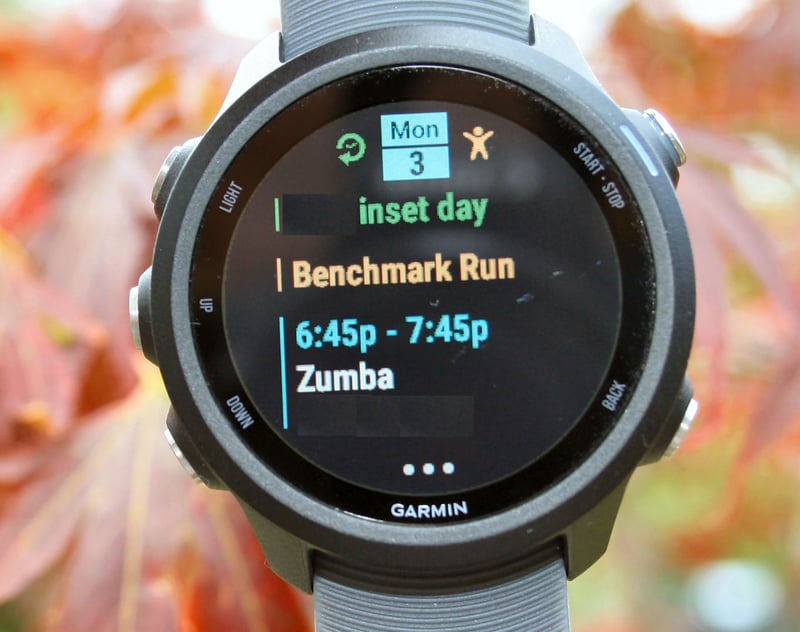
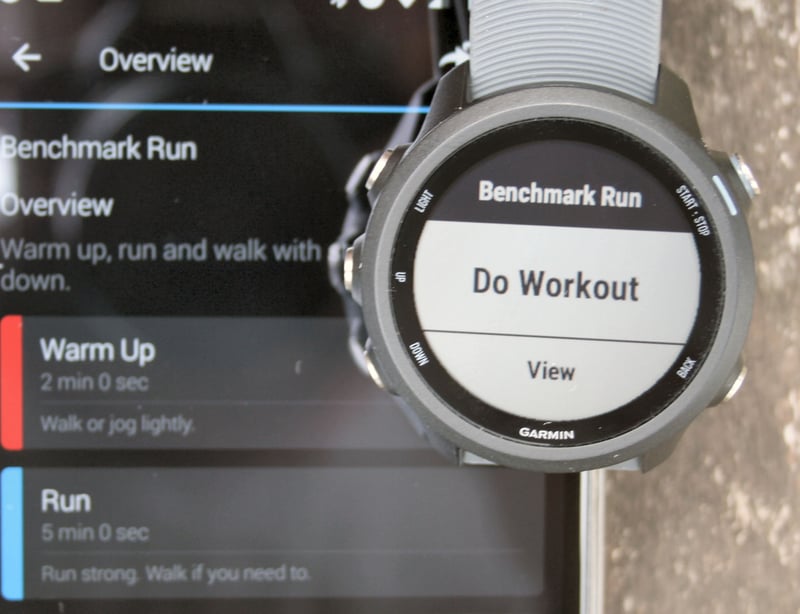
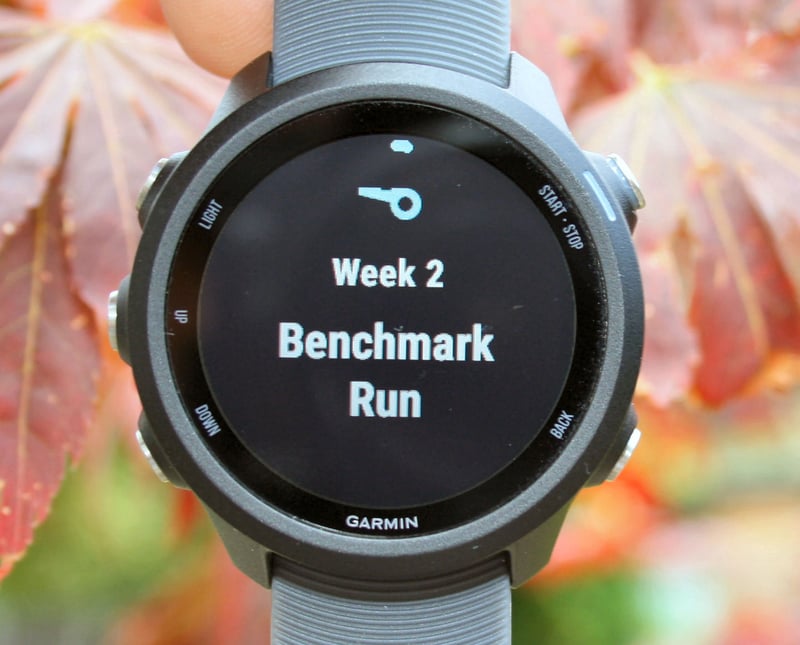
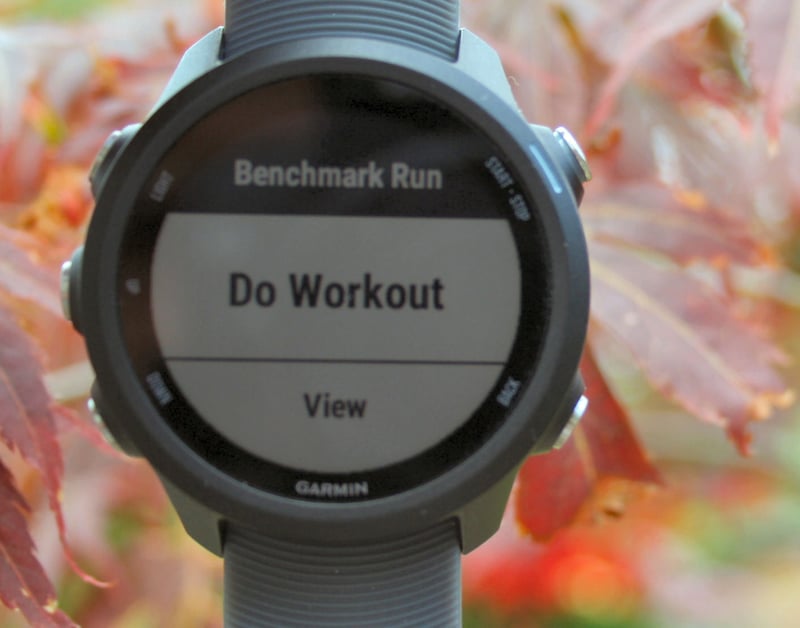
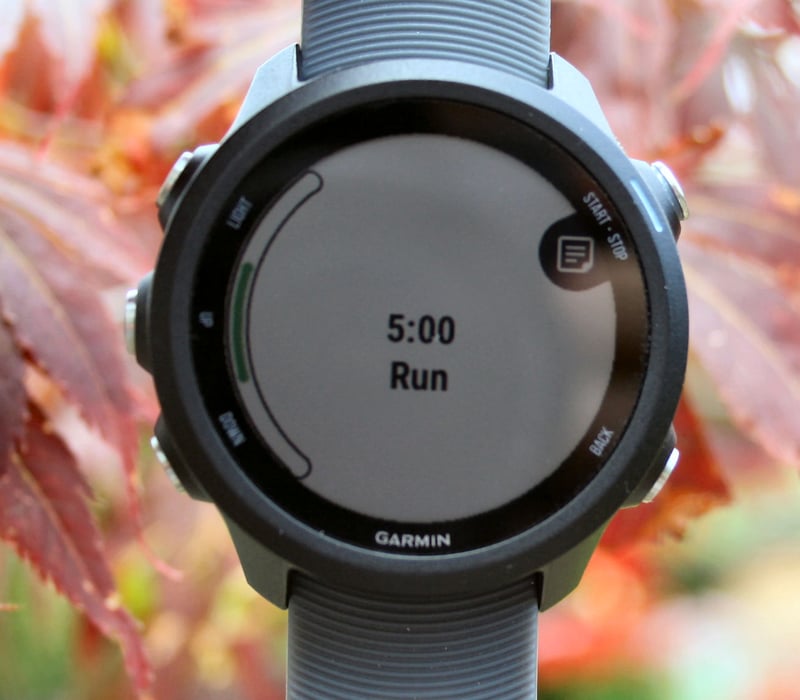










 Analysing Training – The Garmin Connect Platform (web + online)
Analysing Training – The Garmin Connect Platform (web + online) Design & Specifications
Design & Specifications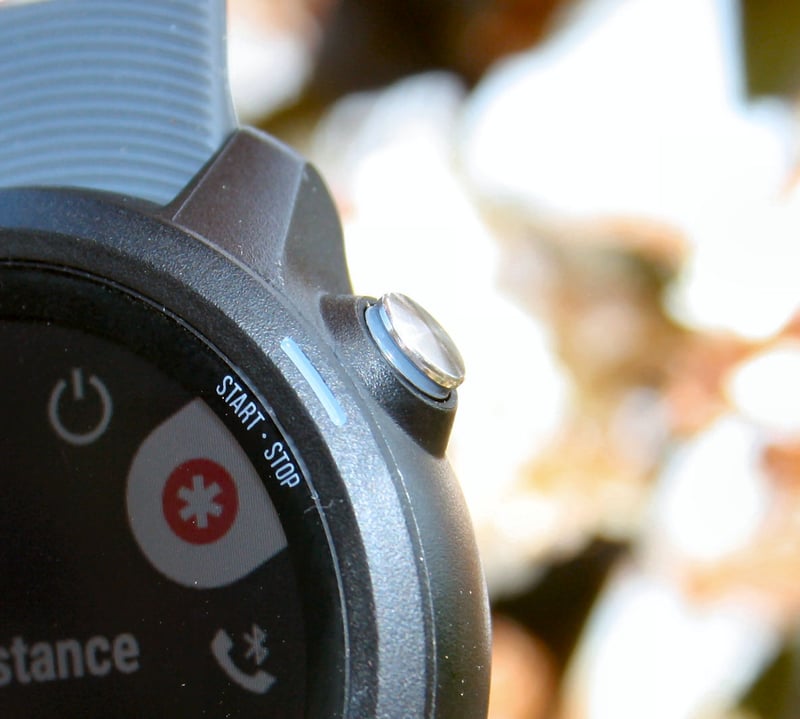
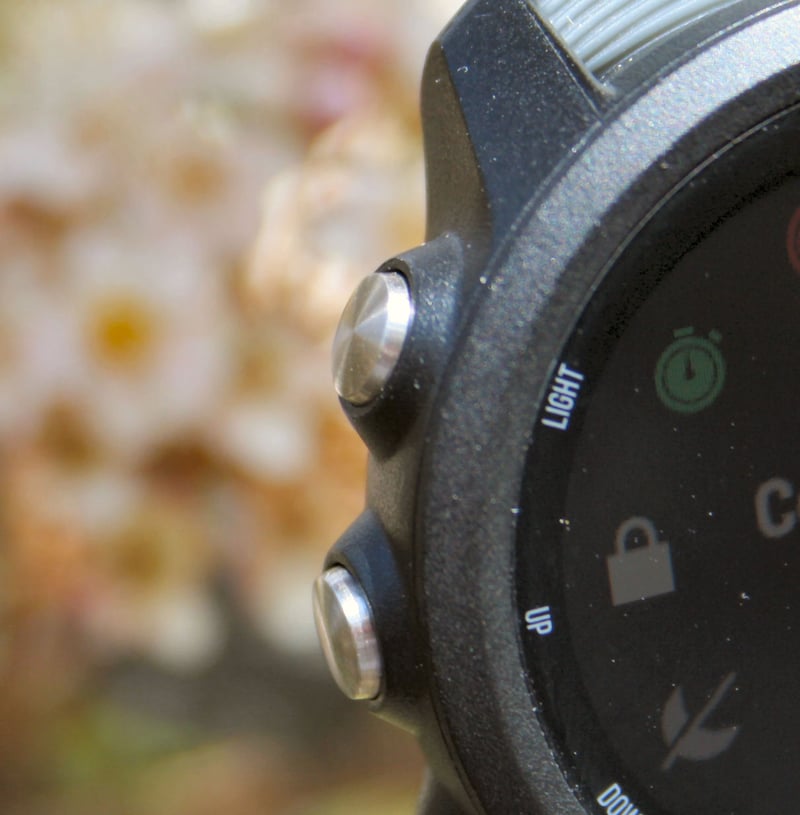
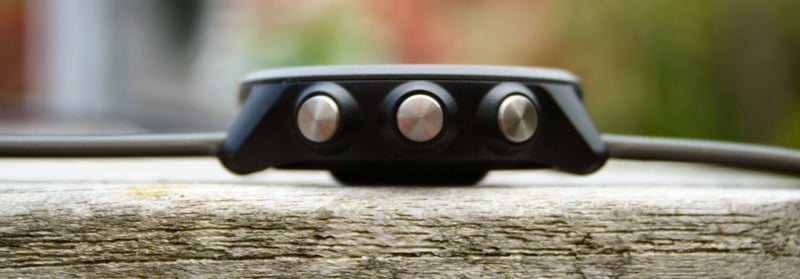










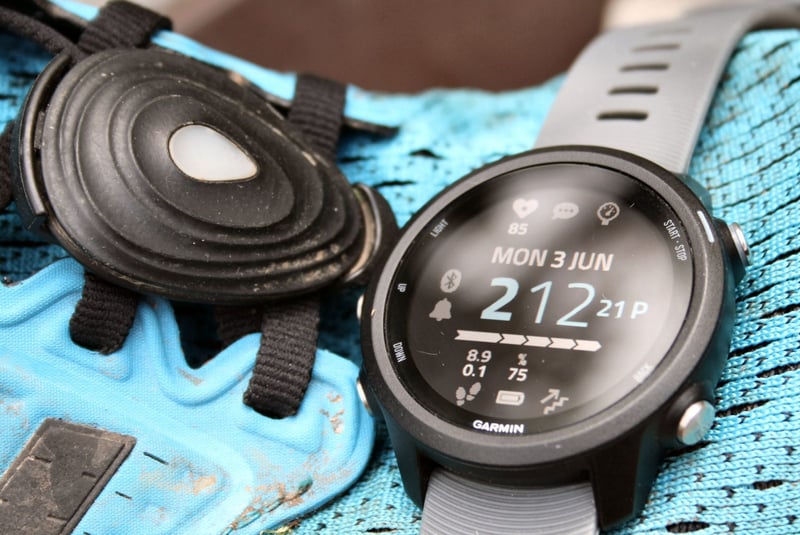
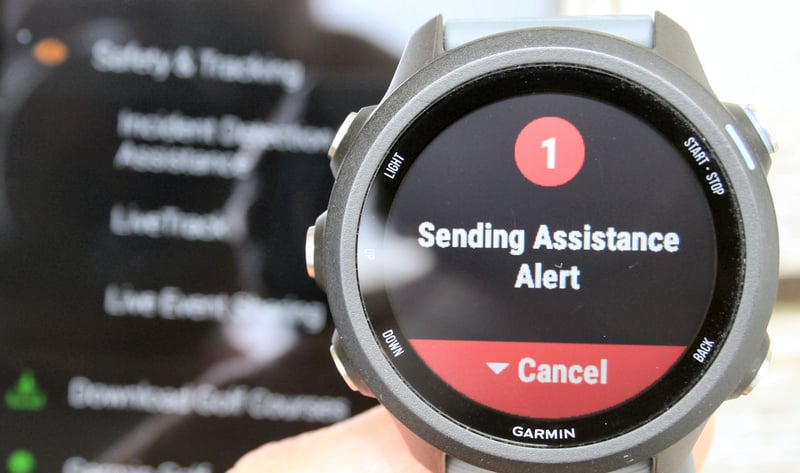
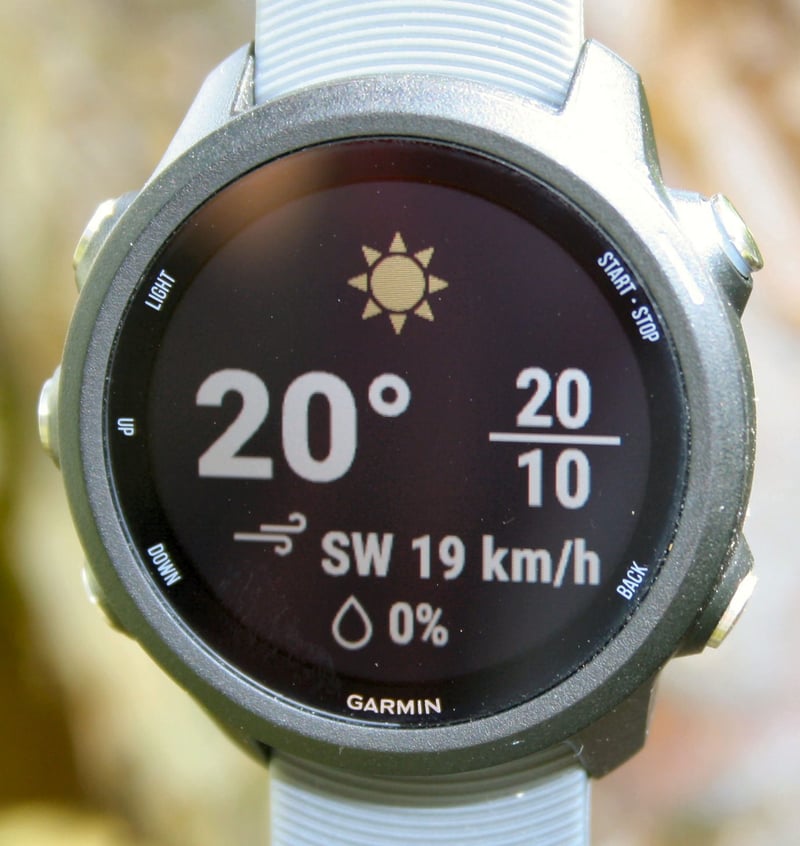
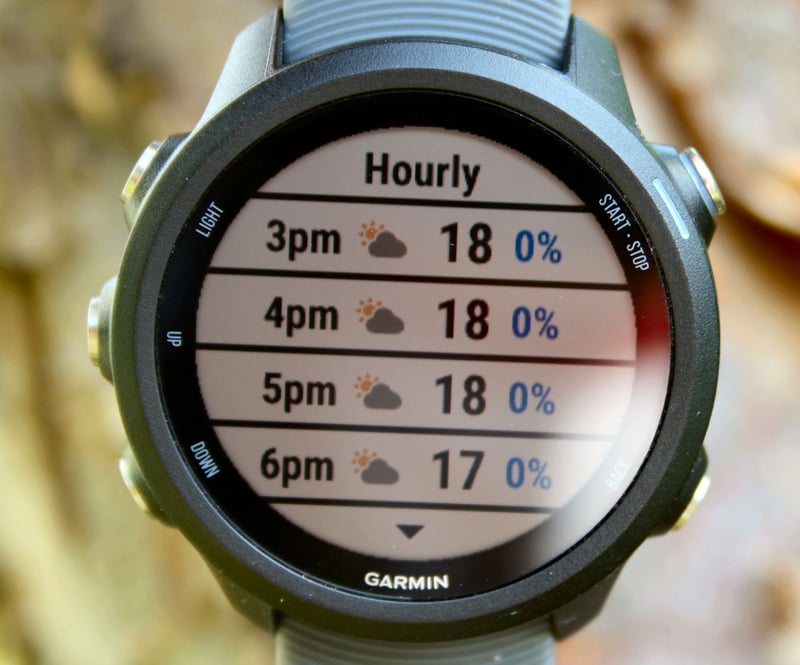
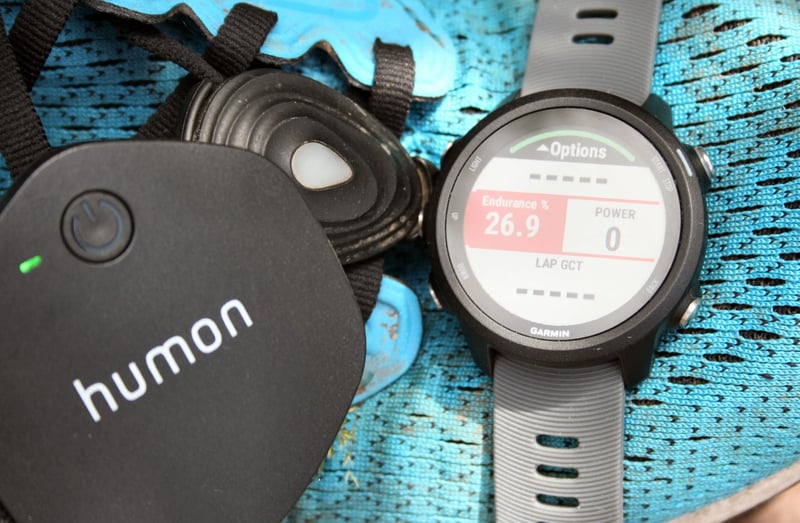
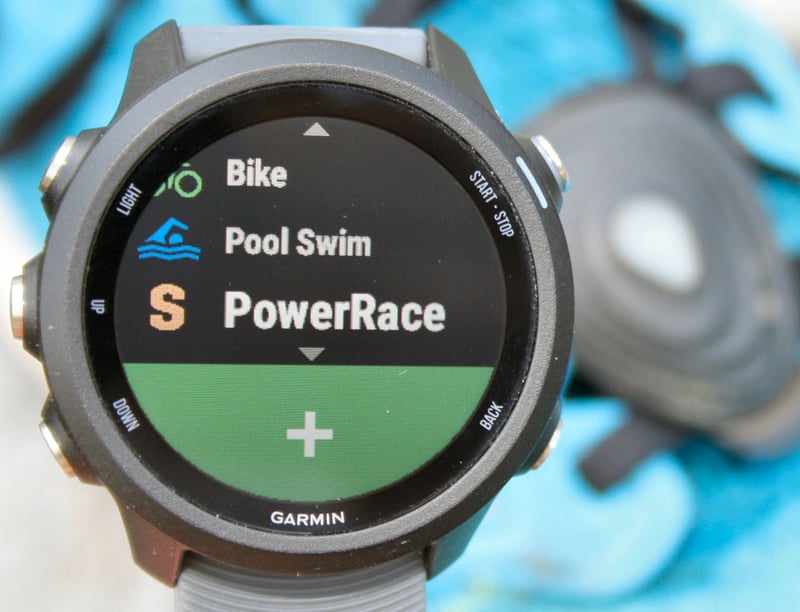
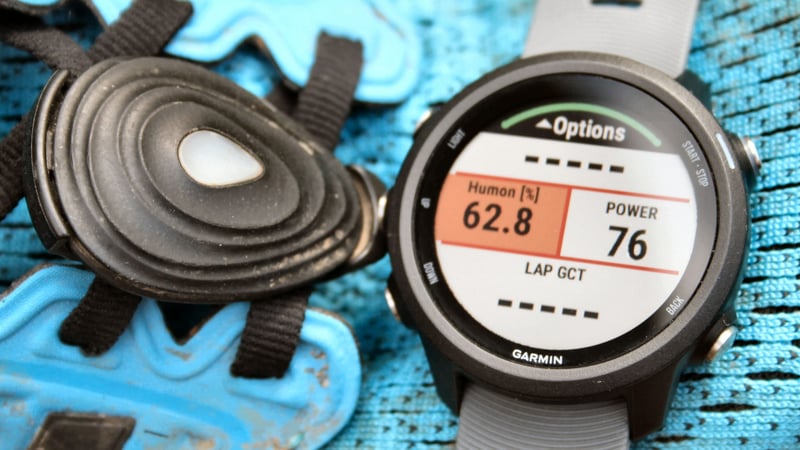
 Special Feature – Running With Power
Special Feature – Running With Power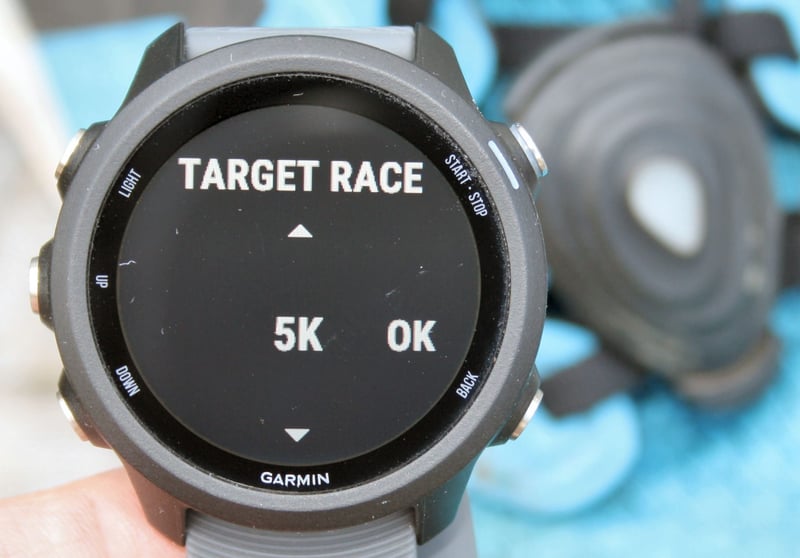
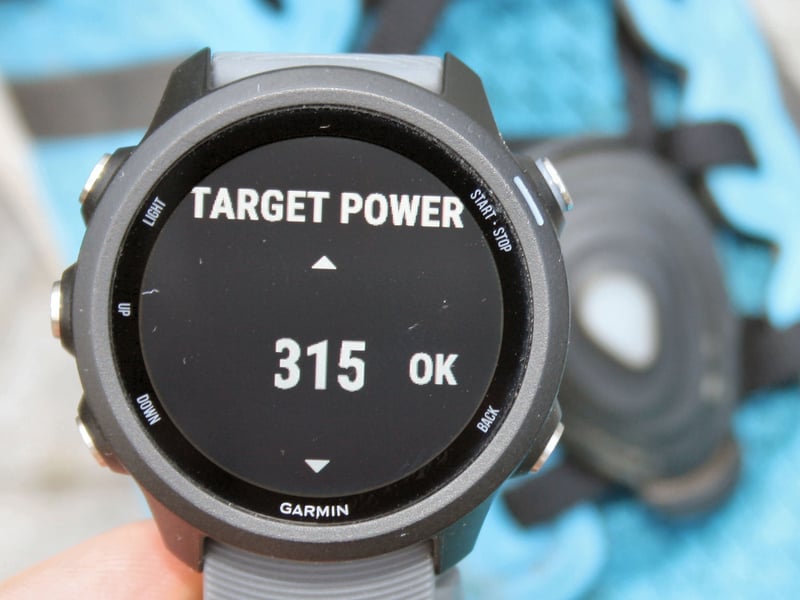
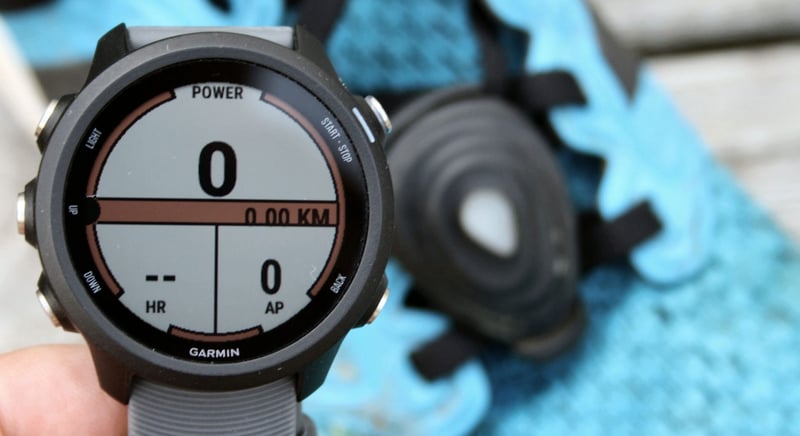
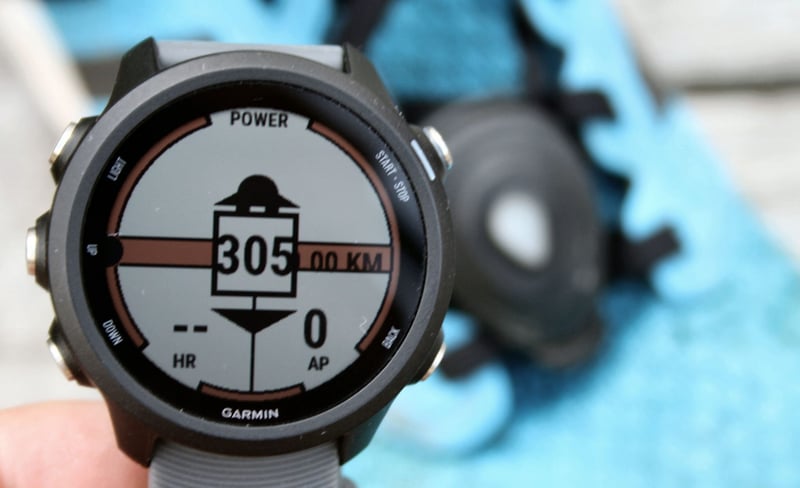
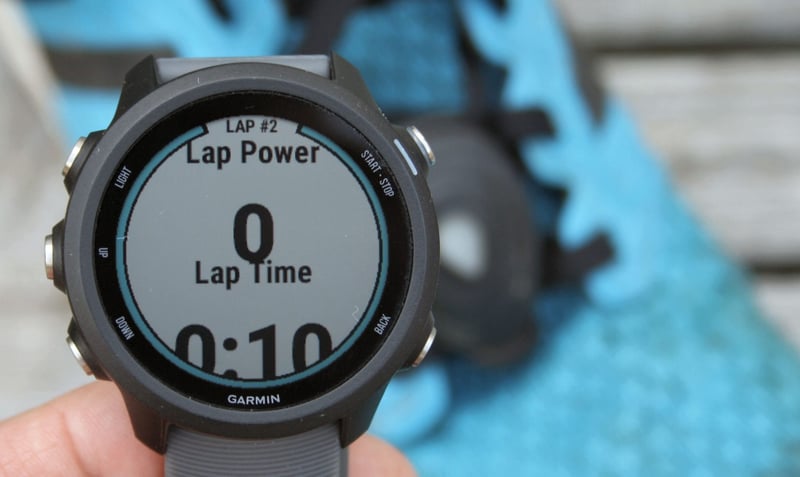















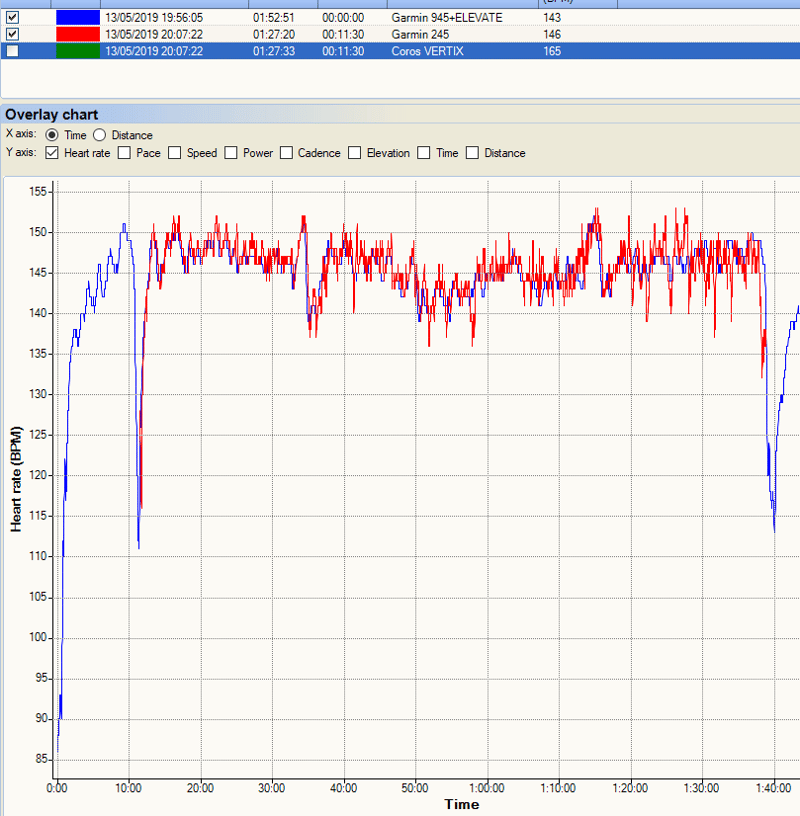
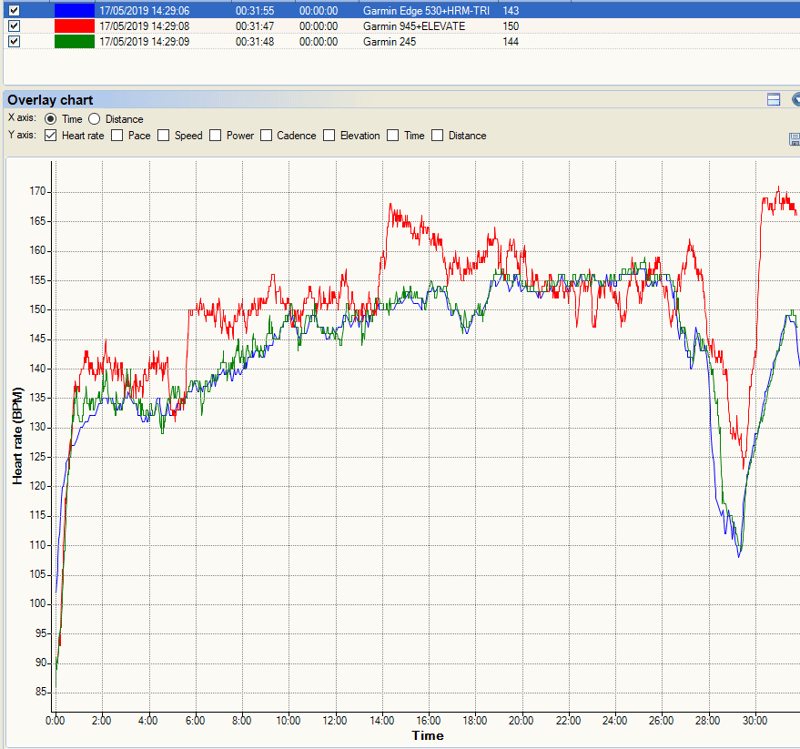
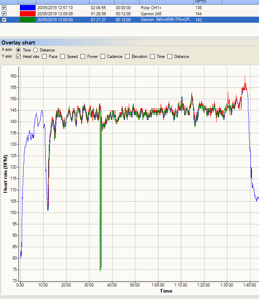
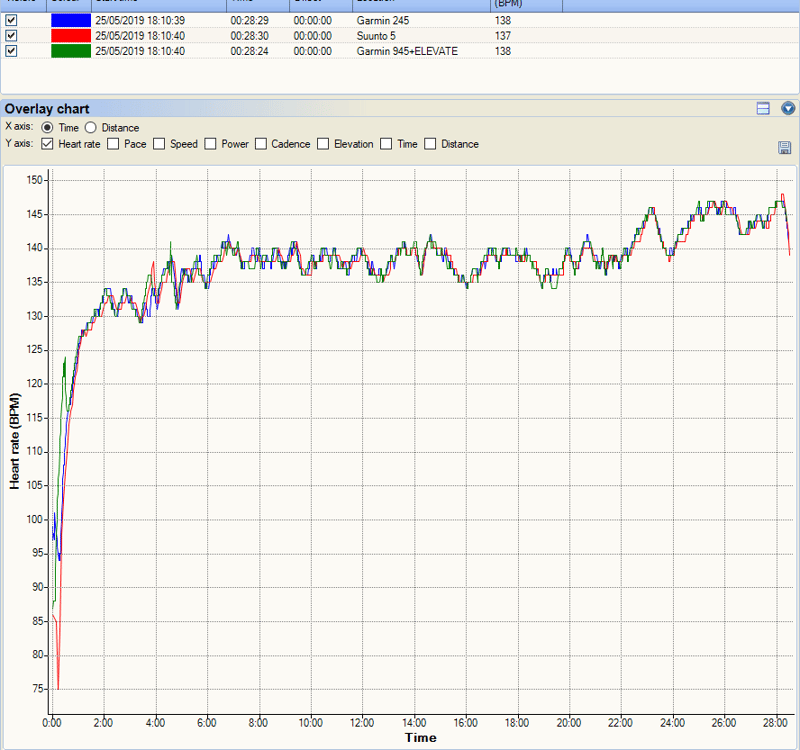
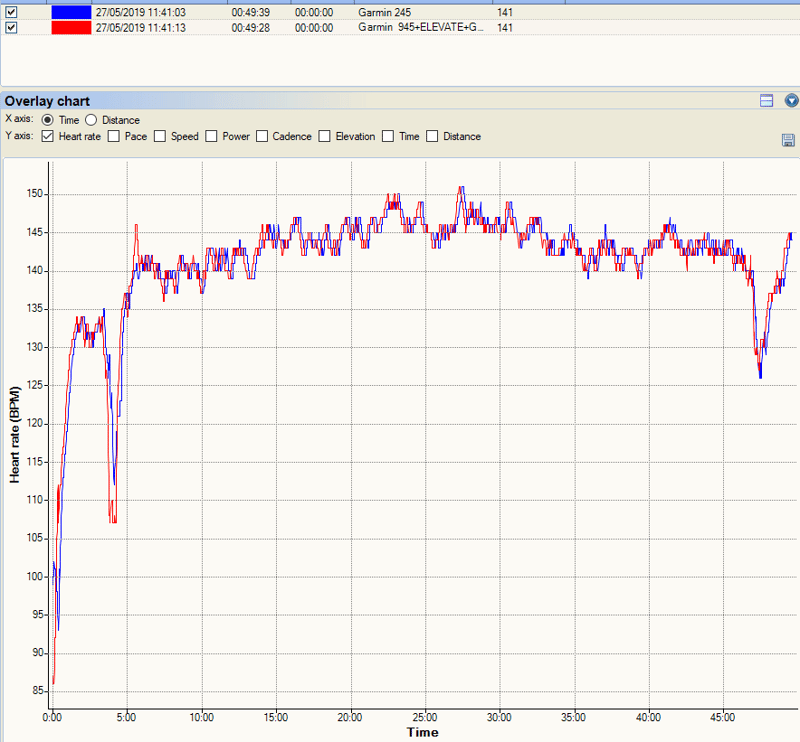

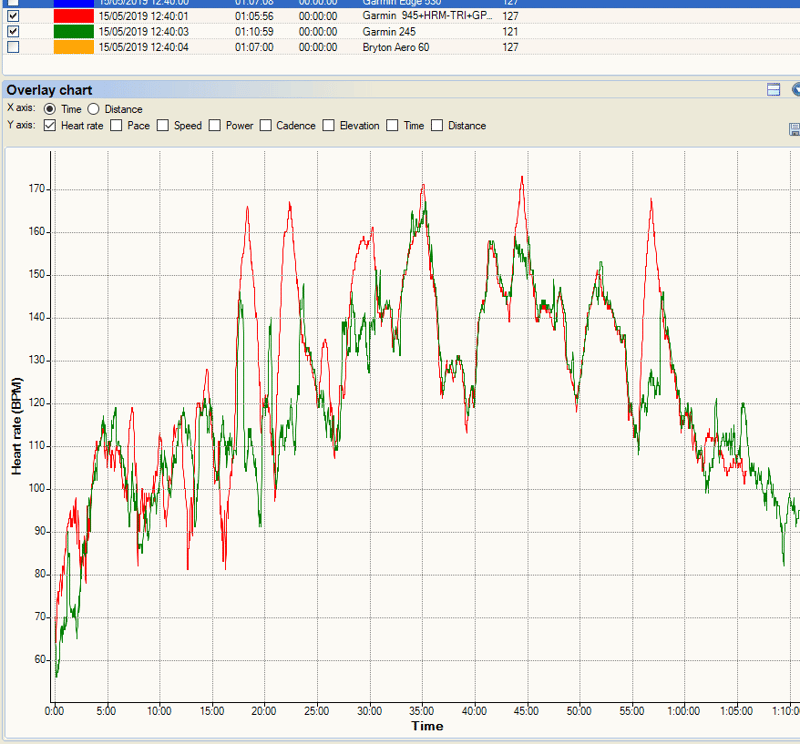
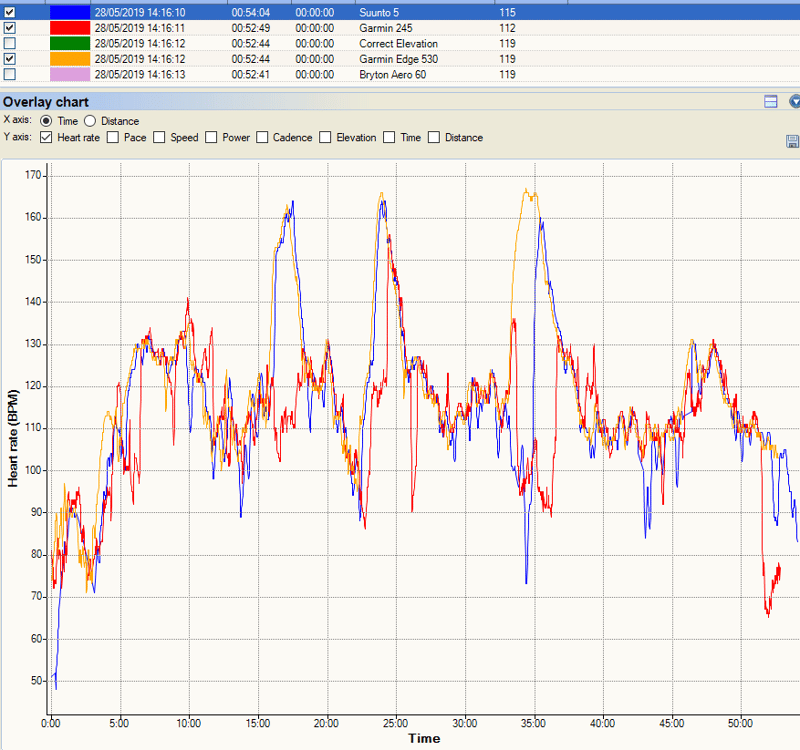

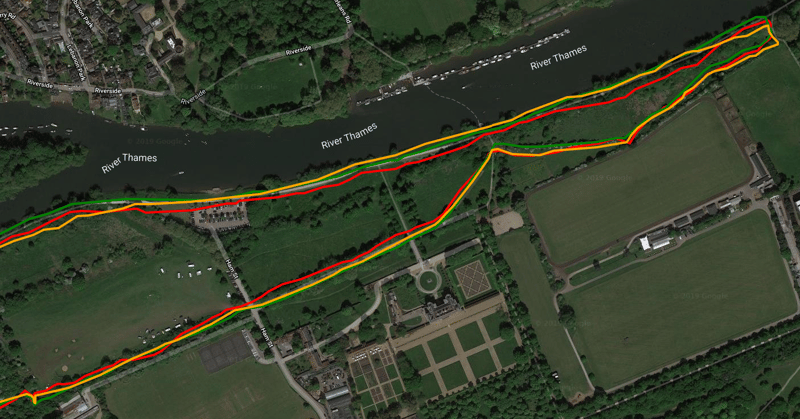




Pros:
-Looks nice on a thin wrist
-Has better GPS track than the Polar Vantage M (both had the latest firmware and up to date AGPS data)
Cons:
-Build quality is worse than expected (comparing to Polar/Suunto products); buttons sucks
-Missing Polar Flow 🙂
Comments:
-You have to switch on 7/24 HRM to have SpO2 reading during the night (from midnight until 4 am), which is a battery sucker
-No sleep/oxygen saturation diagram on the watch
-(BT footpod) pace resolution is 5s; therefore AutoPause has also phase delay
Does the 245M support recording GPS, while getting speed and distance from Stryd?
yes
Great review 🙂 I have an old Polar M400 watch for running. GPS track is decent and instant pace is so-so. Will I gain any accuracy with Garmin 245? I have a max 300 EUR budget and can also get Vantage M or Garmin 645 for 250 EUR. If I understand correctly 245 and Vantage M use same GPS chip from Sony and 645 use older chip with better accuracy and more battery drain? I don`t need any fancy smart watch functions but altimeter would be a bonus. Good accuracy is most important for me. Best thing would be to buy stryd sensor but unfortunately M400 does not support it. So, 245, 645 or Vantage M for me?
i reckon accuracy of all those are about the same: https://the5krunner.com/2016/11/05/test-route-for-gps-devices/
dont get hung up about the chip. it’s not the chip per se it’s how its implemented per manufacturer.
go for any old footpod. that will improve pace somewhat. all the non-stryd footpods really need calibration at your desired speed for super accuracy
tbh they are all similar for you, you seem tounderstnad the pros and cons of each so i wont repeat them.
as i said in the article personally i’d go for VM+stryd+h10, but even then polar need to add the stryd calibration (late 2019)
645 gives GRP but then again it’s older tech inside. but you can prob get it in the sale for a good price
Really happy with it so far, although without intending too I’ve started getting into running trails over the last month or so so will see how the lack of barometric altimeter comes into play.
Don’t understand some of the comments re: getting music on the watch being fiddly. I have a Spotify Premium account and can select albums/playlists direct on the watch, select for download, and within a couple of minutes it’s there saved on the watch for offline use (i.e. out on a run). Not hard in the slightest, and FAR, FAR better than attempting to get music on to my old Ticwatch E via my old Google Play Music account. Although appreciate without a Spotify Premium account it may be a different matter.
i have an S+ account. getting tracks from WMP/personal library was time consuming. I thought WearOS+G-play was pretty easy, s+ not that much harder admittedly. Ifound runcast quite easy too but there are reports elsewhere of others who did not. I guess most things become quicker once you are familiar with them from repeated use.
Surprised by your gps results. The 245 has performed on par with or better then my Suunto spartan trainer. I was curious about the Suunto 5 as I do like the UI more with Suunto. I’ll have to test further for gps results since that is the main function for a gps watch.
Would you say you prefer the Suunto 5 over the 245?
all results here
https://the5krunner.com/2016/11/05/test-route-for-gps-devices/
the watches could be for different purposes
if i was using hrm-run and stryd (or suunto smartbelt and stryd) then i would go for the 245. garmin’s simple ability to be visible as a mass storage device/drive letter is important for me.
What would you use the Suunto for? Your review on the spartan trainer is one of the main reasons I went with it. It has been a great watch as far as GPS accuracy goes. Build quality on the other hand was subpar. My screen lifted on one watch and the other froze constantly. The other reason I went with the 245 was the battery life
the suunto trainer/s5 is not targetted at me.
surprised to hear baout the build quality. I will keep an eye on that topic as am working on the s5 now.
I’m hoping the 5 hasn’t a better build quality being that it’s made in Finland while the trainer was made in China. It’s actually what made me consider going back being that I found it to be a nice unit with great gps accuracy but that’s lack of build quality is what ultimately pushed me towards the 245.
Btw just ran with the new update and my GPS was notably worse then before. Not good
Had mine a couple of weeks now and enjoying it. First smartwatch I’ve had and pleased with the look, feel, size and weight of it.
I did have a slight issue where Spotify seemed to crash but a reboot fixed it.
Just went on a 6k run through various fields and overgrown paths (auto-generated in connect) and managed to navigate just with the watch which was good.
tut tut.
just stick to the 5k runs, they’re the best 😉
Ha, well I asked for a 5k but it gave me 6.6 instead
Can I use HRM swim with it?
Thanks!
not for cache retrieval, you ONLY get that with the tri watches. ie not even the 645 will do that.
but it would work (uncomfortably) for running as a regular hrm
Hey, some people on garmin forum are complaining over button quality. Did you notice strange noises when pressing buttons or buttons got stuck?
they seem ok. could be better.
they press. do their stuff, then unpress.
who could ask for more?
Great review!
Given that the 245 (or any other Garmin device) doesn’t record heart rate while swimming, I assume pool swimming activities don’t contribute to training load/recovery status. Is that correct?
I can’t decide between this one and the Vantage M…
yes 😉
which GPS mode would you recommend (for Europe)?
for general route recording then go for gps. add in galileo for built up urban areas (>3 story buildings)
YMMV of course, but I’d just like to add my experience.
I live in London and I’ve ended up finding that GPS + Glonass has so far been more accurate (or at least more consistent) than GPS alone, or with Galileo. I did get one really good track with Galileo, but have been unable to repeat this. After about 12+ runs of 5k, and using it to track my 2.5k walk to and from work every day, I’m pretty underwhelmed with the gps performance: I get the occasional good track, a few alright ones, and the rest are just plain bad.
I’m on my second 245, Garmin seemed to think the first was defective, but the replacements GPS performs in the same way. Which is a shame because I like everything else about it.
I’m impressed with your stuff: https://www.behance.net/trevorwhite
urban areas are tricky for gps/glonass/galileo…any system.
Hi, does it actually have a gyroscope? My understanding is that it does not.
it’ll have an accelerometer
Does it measure ascent and descent during running ?
yes via gps-altimetry.
it can also show 3d distance i believe
thank you for any support you give to this site: https://geni.us/GarminForerunner245
I am unable to change the step pace and step distance that are visible within the workouts section. Does anyone know how to change these if it’s at all possible? You can easily change the other data fields for the runs but I haven’t yet figured out this one.